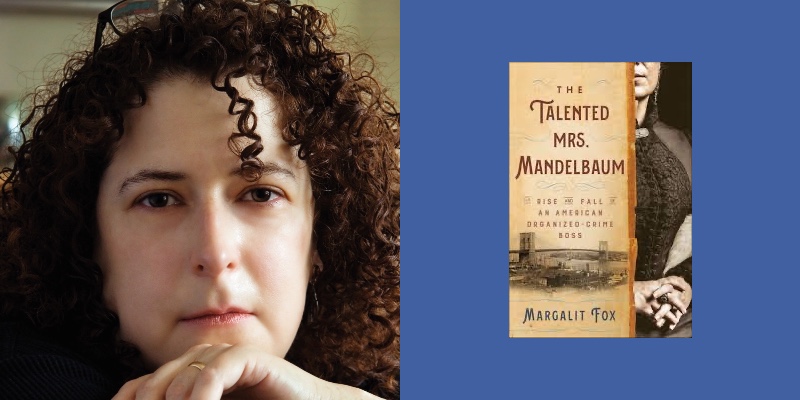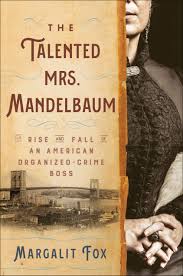Fredericka Mandelbaum was a mother of four, a successful shopkeeper, an employer who appreciated unusual talent—and one of her era’s great criminal pioneers. The ingenious, imposing subject of Margalit Fox’s rollicking new book—The Talented Mrs. Mandelbaum: The Rise and Fall of an American Organized-Crime Boss—was a German Jewish immigrant in 19th century Manhattan. Lacking connections in the legit job market, the struggling door-to-door peddler reinvented herself as an extraordinarily successful dealer in stolen property—a fence.
For more than two decades ending in the 1880s, Mandelbaum’s Lower East Side store was a front for larcenous activity, a base from which she sold pilfered gems, stolen silk and other fineries. She cultivated a roster of thieves, paying some weekly salaries. It was a lucrative setup. By the time the authorities caught on, Fox writes, “as much as $10 million”—$300 million in today’s money—“had passed through her little haberdashery shop.”
Fox is the author of excellent true-crime titles like Conan Doyle for the Defense and a writer whose byline appeared atop hundreds of elegantly crafted obituaries before her retirement from The New York Times in 2018. In a recent interview, she explained how the six-foot-tall, 250-pound Mandelbaum—“she resembled,” Fox writes, “the product of a congenial liaison between a dumpling and a mountain”—became a groundbreaking figure, professionalizing her slice of the nation’s economy.
Mandelbaum was a successful fence for 25 years. How did she get her start?
She came to New York in steerage in 1850, with not much more than the clothes on her back, and she was triply marginalized. She was a foreigner, a woman and a Jew. There were few job prospects of any kind for immigrants, male or female. But, of course, there were more for men. Women were basically confined to backbreaking domestic work, for bupkes.
Many immigrants, denied any chance for economic or social mobility, sought to ascend through what scholars have called the crooked ladder—an underworld ascent rather than in the upper world. But here again, there was total sex disparity. Men could do gambling, numbers-running, be muscle and get out the vote for Tammany (the Democratic machine) on Election Day. Women had two choices in the underworld—shoplifting and prostitution. Shoplifting was a way to stay poor.
And prostitution, as you say in the book, often meant dying young.
That statistic was devastating, that the average life expectancy of a woman entering that trade was four years. So what choice did Fredericka Mandelbaum have? She was smart, she was clearly determined not to remain in poverty. She and her husband were living in tenement poverty, and any legitimate choice they might have had for employment would have kept them in poverty forever. So that was how she wound up where she was. As a woman she couldn’t simply ascend that crooked ladder. She had to build the ladder first.
What was the economic backdrop? There was new paper money, new big-city department stores. A lot was changing.
America was just at that first cusp of what would be called the Gilded Age, which, no surprise, was also the first cusp of the golden age of robbery. Suddenly, upper and middle class Americans had more stuff, better stuff, and there was more to steal. There was certainly theft in America dating back to colonial times, but it was unprofessional. Even in the 19th century when Fredericka arrived, there was what I like to think of as disorganized crime—you saw a woman walking down the street with her pocketbook, you knocked her down and nabbed the booty. But there was no system, no process, no advance planning for what to do with the booty once you have it.
That, of course, is the crucial role of the criminal receiver, the fence: To convert plunder into cash. Fredericka had a genius for spying gaps in the market. She started her own working life in America as a street peddler in New York, and it’s clear that she saw right away that she never would have advanced economically. She knew there was this whole culture of scavengers and petty thieves into which she could tap. So that was the beginning of it.
She built her own crooked ladder.
Absolutely. She asked no questions about the merchandise brought to her; she disguised it if need be, to reduce the chances of identification. And she sold it onward to waiting customers at a profit. She had become a solo entrepreneur.
What would I have seen if I walked up to her storefront in 1860?
To all appearances, what was on the street level was an ordinary haberdashery shop. A woman could go in and buy what you would buy in any such shop—a yard of silk, a length of lace. But Fredericka was brilliant at seeing the economic tenor of the times, and what the market would bear. She knew that there was suddenly—with the rise of urbanization, the latter part of the Industrial Revolution, the rise of professional work—an emerging middle class, and they were clamoring for stuff. But you don’t want to pay full price, or even full wholesale price.
And so she brilliantly worked out the economics of a transaction where, let’s say you’re the thief and I’m Mrs. Mandelbaum. You bring me a bolt of beautiful silk. I pay you 10 to 25 percent of wholesale and you, the thief, go away. Now you’re out of the equation and you’re ideally protected from the police. I loved discovering that the word “fence,” in this sense, is from “defence” spelled with a “c” (the British spelling). The fence is the layer of insulation between the thief and the cops.
I won’t give away the ending of your book, but she keeps at it until the mid-1880s. How did she evade the police and manage to satisfy her customers for all those years?
She disguised the material—if there were any identifying marks, she cut them away. Then she sold them to a list of waiting customers, some around the country, because she had this mail order fulfillment house in the back rooms of her shop. She sold to the consumer at half to two-thirds of wholesale. The consumer was delighted—they got a huge discount—and Mrs. Mandelbaum made a great profit.
Her “chicks,” as she called her team of thieves, were a crucial part of her operation.
Right, she called her employees her chicks. She knew that you don’t start building a crime organization with big stuff. She turned her eye to the cohort of women shoplifters that were already hard at work at city department stores. She gave them a kind of safety net. She said, Come and work for me. There will always be bail money if you’re arrested, I will feed you to the gills at my groaning table. And for a while she had thieves actually on weekly salaries.
There were always fences, but I have not seen anyone else who, that early and in such a sustained way, made such a systematized, well-oiled machine. She really understood that this was a business that could be built.
Which, as you write, means she also needed to work the levers of power.
She certainly, more than occasionally, rubbed elbows with upper-world industry types. I mean, for heaven’s sakes, they were down one side of her fine dining table, with the criminals down the other side, all wining and dining very happily together. There’s a wonderful quote from Bertolt Brecht, which I wound up not using. He said, and this is a rough translation, Which is the greater crime, to rob a bank or to found one? These upper-world captains of industry were breaking strikes, making hostile takeovers—doing all sorts of stuff that was, is or should be considered illegal. Yet, of course, only her activities were considered underworld activities.
A great quote you did use sums up the era: “I seen my opportunities and I took ‘em.”
The great Tammany pol George Washington Plunkitt. New York was a wide open town in those years, and everyone, whether they were underworld or nominally in the upper world, was pretty much doing the same stuff. It really came down to what did the law deem legal? And what did the law deem illegal?
I knew obviously this book was historical true crime. I knew obviously it was women’s history. But when I started reading about how she built up the business—heuristically, incrementally, sending up economic trial balloons—into a multimillion dollar concern, I thought, my God, this is a business story above anything else.
This made her well-known over time. Which, it seems, she didn’t entirely mind?
One newspaper—it was a Cincinnati paper, this is how famous she was—said she often wears $40,000 of jewels at once. That’s over $1 million in today’s money. So famous was she, there were stage plays with characters based on her. She goes to see one of them in a New York production, and when the character comes on in this kind of frowzy house dress, Mrs. Mandelbaum goes to the manager of the theater incensed. It’s safe to assume she had tremendous pride in how she had been able to build herself up from nothing.


















